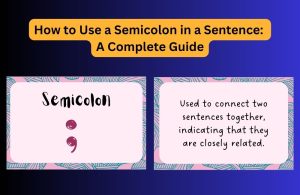This article covers the following areas –
- What is a Sentence Fragment?
- Fragmented Sentence Examples with Correction & Explanation
- Tips for Fragmented Sentence Correction
- Final Thoughts
Understanding and correcting fragmented sentences is a vital skill in writing, ensuring clarity and coherence in your content. Sentence fragments often sneak into our writing, especially when we’re trying to convey thoughts rapidly. Identifying and rectifying these fragments can transform your writing from good to great.
What is a Sentence Fragment?
A sentence fragment is essentially an incomplete sentence. It lacks a main clause, which is crucial for a sentence to express a complete thought. These fragments often appear as bits of sentences that have been improperly separated from a main clause or are missing a subject, verb, or both. Let’s see an example to clarify the definition of a sentence fragment.
Fragment: After the movie ended.
Correction: After the movie ended, we went out for dinner.
In this example, “After the movie ended” is a fragment. It starts with a subordinating conjunction, “after, ” without a complete thought. The corrected sentence adds an independent clause, “we went out for dinner,” which completes the thought, making it a full sentence. This addition addresses the issue of the dependent clause standing alone, providing context and meaning to the initial phrase.
To spot a sentence fragment, look for these key elements:
- Absence of a Main Clause: If a group of words doesn’t contain a main clause, it’s a fragment.
- Missing Subject or Verb: Check if the sentence has both a subject (who or what the sentence is about) and a verb (action or state of being).
- Dependent Clauses Standing Alone: Dependent clauses, despite having a subject and verb, don’t express a complete thought and need an independent clause to make sense.
Fragmented Sentence Examples with Correction & Explanation

Let’s dive into some detailed examples to further our understanding of fragmented sentences and their corrections. These examples will span various types of fragments, including missing main clauses, absent subjects or verbs, and dependent clauses left standing alone.
1. Missing Main Clause
A main clause is a key part of a sentence that contains a subject and a verb, expressing a complete thought. Sometimes, sentences lack a main clause, making them fragments.
These incomplete sentences often start with words like ‘while,’ ‘after,’ ‘during,’ or ‘following,’ but do not provide enough information to stand alone as a complete thought. Let’s look at some examples of fragments missing a main clause and how to correct them.

| Fragment | Correction | Explanation |
|---|---|---|
| While walking to the store. | While walking to the store, I saw an old friend. | ‘While walking to the store’ is a fragment as it’s a dependent clause that cannot stand alone. |
| After the rain stopped. | After the rain stopped, the birds started singing. | This fragment lacks a complete idea. The addition of ‘the birds started singing’ completes the thought. |
| During the summer holidays. | During the summer holidays, we visited our grandparents. | The fragment doesn’t convey a complete thought. Adding ‘we visited our grandparents’ makes it complete. |
| In the quiet morning hours. | In the quiet morning hours, she wrote her novel. | Here, the fragment is missing a main clause. The addition of ‘she wrote her novel’ completes the sentence. |
| Following the instructions carefully. | Following the instructions carefully, he assembled the furniture. | The phrase is a fragment without a main clause; adding ‘he assembled the furniture’ resolves this. |
2. No Subject
Sentences require a subject to indicate who or what is performing the action of the verb. When a sentence lacks a subject, it becomes a fragment. These fragments often include a verb or verb phrase but do not specify who or what is carrying out the action. Here are examples of such fragments and how to correct them by adding a subject.

| Fragment | Correction | Explanation |
|---|---|---|
| Ran to the bus stop. | She ran to the bus stop. | The verb ‘ran’ lacks a subject. Adding ‘She’ completes the sentence. |
| Jumped over the fence. | The dog jumped over the fence. | Missing a subject. Adding ‘The dog’ provides the necessary subject. |
| Was singing loudly. | The bird was singing loudly. | The fragment lacks a clear subject. Introducing ‘The bird’ as the subject completes the sentence. |
| Can be extremely challenging. | Learning a new language can be extremely challenging. | Without a subject, the phrase is incomplete. ‘Learning a new language’ as the subject resolves this. |
| Must be evaluated carefully. | Each application must be evaluated carefully. | The verb ‘must be evaluated’ needs a subject, provided by ‘Each application’. |
3. Dependent Clause Alone
Dependent clauses are parts of sentences that cannot stand alone as they do not express a complete thought. They are often introduced by subordinating conjunctions like ‘because,’ ‘since,’ ‘although,’ or ‘if.’ When used alone without an independent clause, they create sentence fragments. Let’s examine some examples of fragments consisting of only a dependent clause and how to correct them.

| Fragment | Correction | Explanation |
|---|---|---|
| Because she was late for the meeting. | She took a taxi because she was late for the meeting. | The fragment is a dependent clause that doesn’t express a full thought on its own. |
| Since it was raining. | We stayed indoors since it was raining. | ‘Since it was raining’ is a fragment, requiring an independent clause for completion. |
| Although he had the skills. | Although he had the skills, he was not confident. | This fragment is a dependent clause and needs a main clause to be complete. |
| If you decide to join us. | If you decide to join us, we can leave together. | ‘If you decide to join us’ is a fragment. It needs an additional clause for completeness. |
| While she pondered the question. | While she pondered the question, time was running out. | The fragment is incomplete and requires an independent clause for completion. |
4. Advanced Fragment Identification
Some sentence fragments are more complex, involving elements like subordinate clauses, relative clauses, or prepositional phrases. These types of fragments require a deeper understanding of sentence structure for identification and correction. We will explore examples of such advanced fragments and demonstrate how to turn them into complete sentences.

| Fragment | Correction | Explanation |
|---|---|---|
| Although the rain was heavy, which was unexpected. | Although the rain was heavy, the event continued, which was unexpected. | Includes a subordinate clause and a relative clause but lacks a main clause. |
| Despite having all the qualifications. | Despite having all the qualifications, he did not get the job. | Starts with a preposition and lacks a main clause. Adding an independent clause completes it. |
| Given the current circumstances. | Given the current circumstances, we need to reassess our strategy. | This fragment lacks a complete thought. Introducing a main clause resolves this issue. |
| Considering her expertise in the field. | Considering her expertise in the field, she was the best candidate for the project. | The fragment is a dependent clause and requires an independent clause for completion. |
| Owing to the severe weather conditions. | Owing to the severe weather conditions, the flight was delayed. | The phrase is a fragment as it does not form a complete sentence on its own. |
These examples showcase the importance of identifying and correcting fragmented sentences in various contexts. By understanding the common types of fragments and practicing with these examples, one can significantly enhance their writing skills, ensuring clarity and completeness in every sentence.
Tips for Fragmented Sentence Correction
Correcting sentence fragments is a crucial aspect of crafting clear and effective writing. While sentence structure might seem straightforward, fragmented sentences are a common issue that can disrupt the flow and clarity of your writing. Fortunately, several strategies and tools are available to help identify and fix these fragments.
- Online tools like Grammarly and Hemingway Editor are incredibly useful for identifying sentence fragments. These tools analyze your text and highlight potential issues, including incomplete sentences. However, it’s important to remember that these tools are not infallible. They can sometimes miss nuances of language or the writer’s intended tone.
- For the best results, consider using a combination of these tools. Each has its strengths – for example, Grammarly is excellent for grammar and syntax checks, while Hemingway Editor excels at improving readability.
- Reading your work aloud is a time-tested method for catching sentence fragments. This practice helps you hear the natural rhythm and flow of your writing, making it easier to spot incomplete thoughts or awkward phrasing. If something sounds off when read aloud, it often indicates a potential sentence fragment or other grammatical issues.
- Peer review is invaluable for identifying sentence fragments and other errors. Sometimes, a fresh pair of eyes can catch mistakes that the original writer overlooks. Encourage peers to provide honest feedback and consider their suggestions carefully. Websites like Scribophile or ProWritingAid’s Writing Community offer platforms for writers to share their work and receive constructive critiques.
- Develop a solid understanding of basic sentence structures. Websites like Purdue OWL offer comprehensive resources on sentence construction and grammar rules.
- The more you write, the better you become at identifying sentence fragments. Regular writing practice helps you naturally develop a sense of sentence rhythm and flow.
- Participating in writing workshops can also be beneficial. These workshops often focus on sentence-level issues and offer practical exercises to improve your writing. Look for local workshops or online courses on platforms like Coursera or Udemy.
- Having a reference guide or a grammar handbook nearby can be a quick way to check if a sentence is complete. Books like The Elements of Style (Amazon Link) by Strunk and White provide timeless sentence construction and style advice.
By employing these strategies, writers can significantly improve their ability to identify and correct fragmented sentences. The key is to combine these methods for a well-rounded approach to refining your writing skills. Remember, practice and patience are essential, as improving writing skills is gradual.
Final Thoughts
Identifying and correcting sentence fragments is crucial for clear, effective communication. Whether you’re writing a blog, academic paper, or a simple email, ensuring your sentences are complete enhances readability and professionalism. As someone who revels in the art of writing, I encourage you to take the time to master this skill, elevating your writing to new heights.






